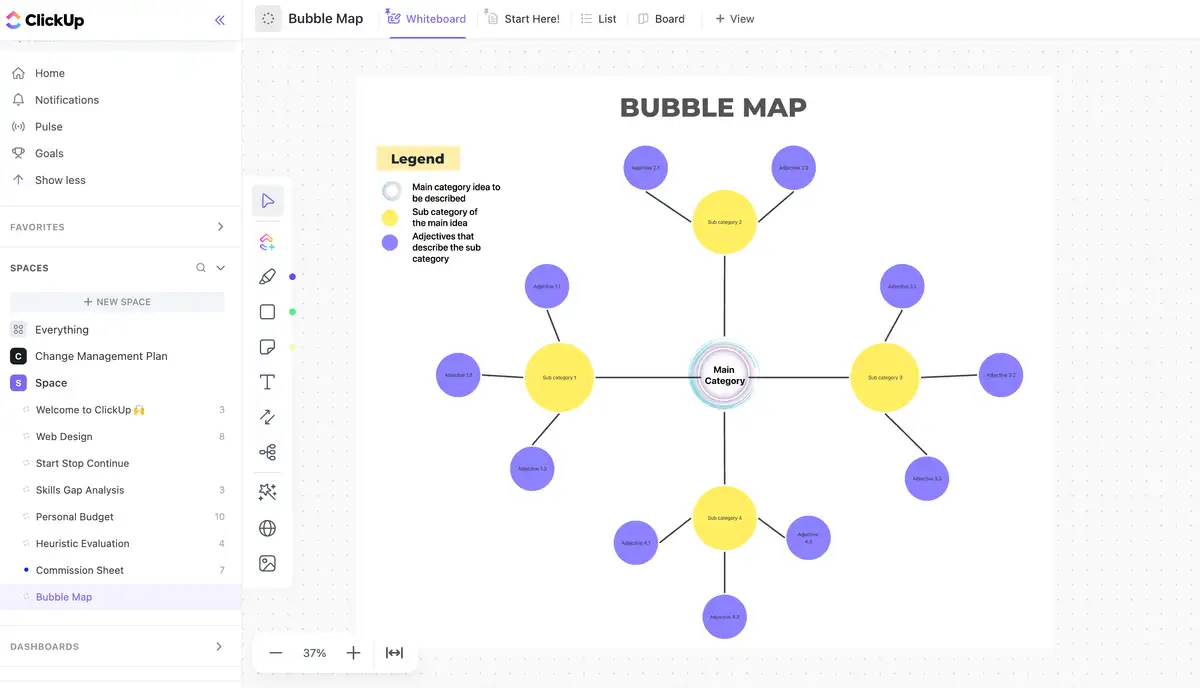Have you ever found yourself stuck trying to solve a complex problem or overwhelmed with countless tasks? The bubble map is an incredibly useful tool to visually illustrate how different ideas, concepts, and components connect and overlap. Not only does this system provide clarity when grappling with disparate information sources, but it can also be used as an effective way to see patterns or trends that may otherwise go unnoticed.
Whether in the creative sector or for business leaders and team leaders looking for the best approach for their organization, the bubble map offers endless opportunities for efficient solutions! Read on to learn more about bubble maps and how the bubble map template in ClickUp can help you create successfully your own.
Whether in the creative sector or for business leaders and team leaders looking for the best approach for their organization, the bubble map offers endless opportunities for efficient solutions! Read on to learn more about bubble maps and how the bubble map template in ClickUp can help you create successfully your own.
What is a bubble map?
A bubble map is an organizational tool designed to help visualize complex relationships between ideas, concepts, and components. It is often used in the creative sector as well as for business decision-making purposes because of its ability to provide clarity and identify patterns that might go unnoticed otherwise.
The template consists of a series of circles or “bubbles” which contain information about various entities, and arrows pointing from one bubble to another that show the relationships between them. The size of each “bubble” can be adjusted to indicate the importance or relative significance of the entity it represents. The circle itself can also be broken up into sections to represent different properties or characteristics, allowing multiple levels of information to be included on one page. This makes bubble maps an excellent way to present complex data in a visually-intuitive manner.
By using a bubble map, you can quickly and easily gain insight into the complexities of your problem or idea. The end result is a well-structured visualization that helps to identify problems, solutions, and opportunities. ClickUp's bubble map template offers great flexibility and is a very powerful tool for businesses and individuals alike. It is the perfect way to bring structure and clarity to any project or decision-making process.

Pictured: A blank bubble map example using ClickUp's bubble map template.
The main benefits of using a bubble map
Bubble maps are helpful in a variety of ways, and here are just a few overarching benefits they offer:
- Providing clarity when dealing with large amounts of complex data
- Identifying patterns and trends that may otherwise go unnoticed
- Allowing multiple levels of information to be included on one page
- Breaking down the complexity into visually intuitive segments
- Helping to identify problems, solutions, and opportunities quickly and easily
- Supporting the decision-making process
What can I use a bubble map for?
Bubble maps are flexible and versatile enough to be used for a host of business use cases, such as:
- Problem solving
- Project planning and management
- Brainstorming and idea generation
- Business strategy development
- Concept mapping
- Identifying trends or patterns in large data sets
- Creating flow charts or timelines
- Conducting word analysis
- Showing the cause and effect of decisions
- Clarifying complex relationships between different entities
- Visualizing multi-dimensional data
- Understanding multiple perspectives on a problem or idea
- Exploring different scenarios and outcomes
- Generating new insights and ideas
- Identifying the strengths and weaknesses of possible solutions
- Creating presentations that tell an engaging story with data
You can even use bubble maps on top of each other by using a double bubble map or a triple bubble map.
How to create a bubble map
Putting together a bubble map can be a challenge, but following these steps can help ensure your success:
Step 1: Determine your purpose.
You first need to identify why you're creating of your bubble map. What specific problem or main idea are you trying to understand?
Step 2: Identify components.
Brainstorm the different entities and components that are related to your central idea. List out all of their characteristics, properties, and relationships.
Use a ClickUp Doc to collaboratively brainstorm
with your team.
Step 3: Create your bubbles.
Create a template with a central circle and other circles, or “bubbles,” that represent each entity or component. ClickUp's bubble map template can do this for you automatically.
Step 4: Demonstrate significance through size.
Adjust the size of the “bubbles” to indicate their relative importance or significance.
Step 5: Create subsections.
Break up each circle into sections to represent different properties or characteristics.
Step 6. Demonstrate relationships.
Connect the bubbles to each other and the central bubble with arrows to show how they are related, and use labels to further specify the type of relationship.
Step 7: Flesh out your map.
Add additional elements to your map such as timelines, flow charts, or other visual elements as needed.
Link elements of your bubble map to tasks, Lists, or people in ClickUp.
Step 8: Review and refine.
Keep revising your bubble map until you are satisfied with its accuracy and clarity.
Use task status settings in ClickUp
to track progress on your bubble map.







